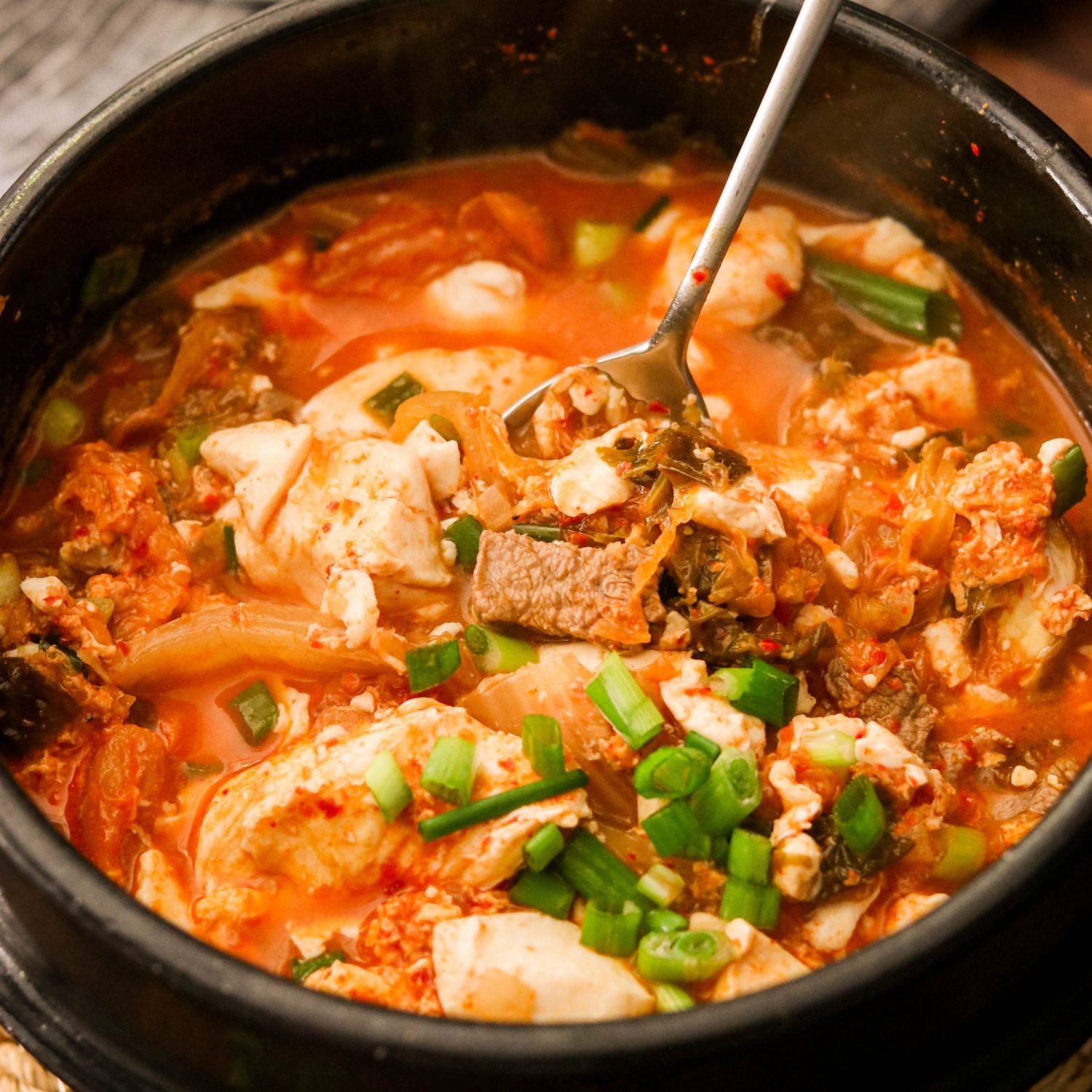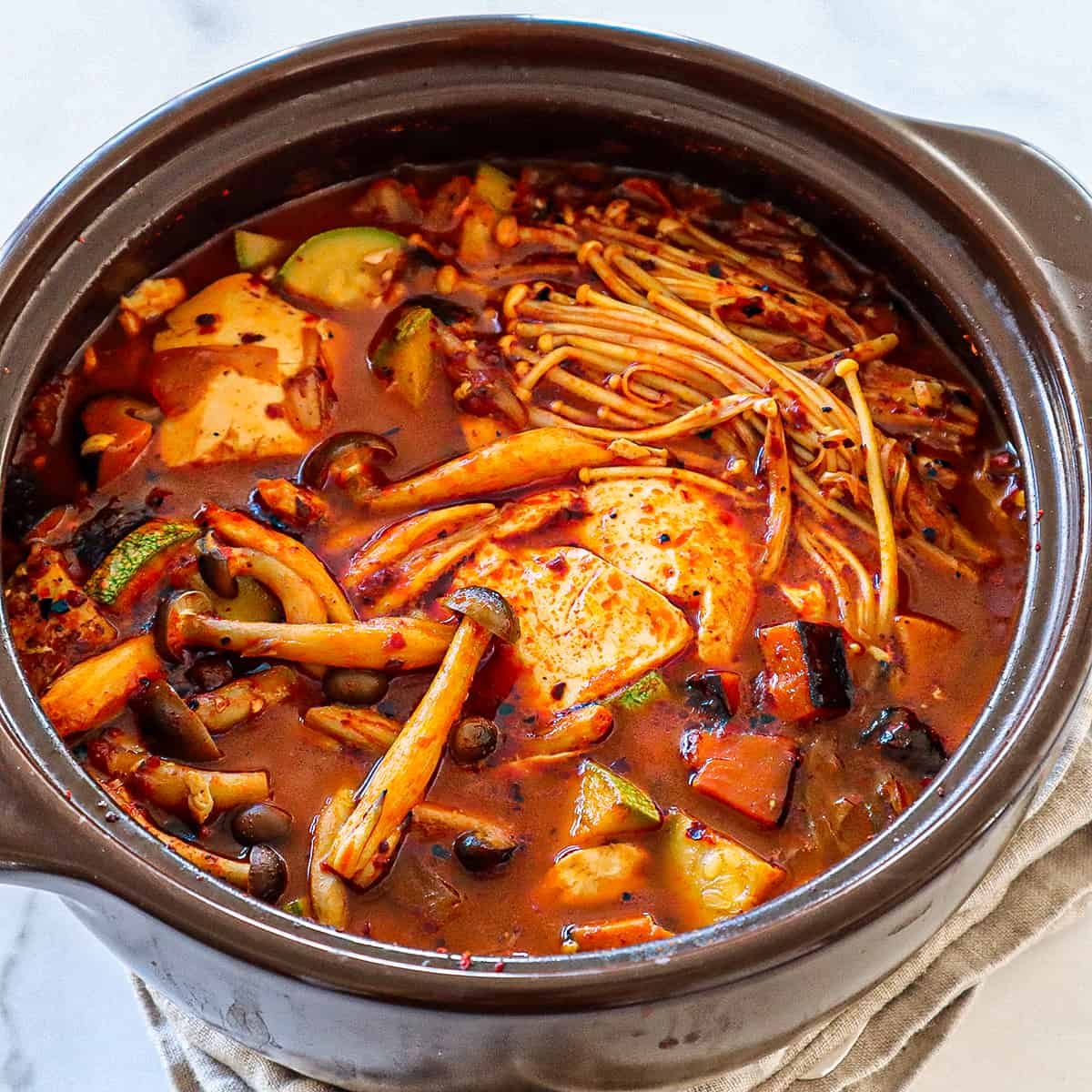Immerse yourself in the delectable world of soondubu, a beloved Korean stew that tantalizes taste buds and warms the soul. With its vibrant broth, tender tofu, and an array of flavorful toppings, soondubu offers a culinary experience that is both comforting and invigorating.
From its humble origins to its regional variations, this dish has become a cherished part of Korean cuisine, enjoyed by people of all ages and backgrounds.
In this comprehensive guide, we will embark on a culinary adventure, exploring the ingredients, preparation methods, and regional variations of soondubu. We will uncover the secrets to creating a flavorful broth, discuss the importance of toppings, and delve into the health benefits associated with this nutritious dish.
Whether you are a seasoned cook or a curious foodie, this guide will provide you with the knowledge and inspiration to create your own unforgettable soondubu experience.
Ingredients

The ingredients used in a traditional soondubu recipe are carefully selected to create a balanced and flavorful dish. Here’s a list of the essential ingredients and their functions:
Essential Ingredients:
- Soft Tofu (Soondubu): The star of the dish, soondubu is a soft and delicate tofu that melts into a creamy broth.
- Seafood: Typically mussels, clams, or shrimp, seafood adds a briny and umami flavor to the stew.
- Vegetables: Mushrooms, zucchini, and green onions provide texture, freshness, and additional nutrients.
- Gochujang (Korean Chili Paste): This spicy and fermented paste is the key to soondubu’s signature flavor.
- Doenjang (Soybean Paste): A savory and salty paste that adds depth and complexity to the broth.
- Chicken or Seafood Stock: Provides a rich and flavorful base for the stew.
- Eggs: Optional, but often added for protein and to thicken the broth.
Variations:
While these ingredients form the foundation of a traditional soondubu recipe, there are many variations based on regional or personal preferences. Some common variations include:
- Kimchi: Adding kimchi to the stew gives it a spicy and tangy flavor.
- Pork Belly: Thinly sliced pork belly can be added for extra richness and umami.
- Different Vegetables: Other vegetables like carrots, spinach, or bok choy can be used to add variety and nutrients.
- Spicy Level: The amount of gochujang can be adjusted to suit individual spice preferences.
Preparation
Preparing soondubu is a simple process that involves cutting and preparing the ingredients, followed by cooking the dish using either a stovetop or a hot pot. The key techniques used in cutting and preparing the ingredients include julienning (cutting vegetables into thin, matchstick-like strips) and mincing (finely chopping ingredients such as garlic and ginger).
Stovetop Method
- In a large pot or Dutch oven, bring the chicken or vegetable broth to a boil.
- Add the tofu and bring to a simmer.
- Add the remaining ingredients and cook until the tofu is heated through and the vegetables are tender.
Hot Pot Method
- Fill a hot pot with water or broth.
- Bring the liquid to a boil.
- Add the tofu and remaining ingredients to the hot pot.
- Cook the ingredients until the tofu is heated through and the vegetables are tender.
Broth

The broth is the backbone of soondubu, providing depth of flavor and umami.Different types of broth can be used, each imparting its unique character. Anchovy broth, made from dried anchovies, offers a rich, salty flavor. Beef broth adds a savory and hearty note, while pork broth contributes a lighter, more delicate taste.To
create a flavorful and aromatic broth, it’s crucial to use high-quality ingredients and simmer the broth for an extended period. This allows the flavors to develop and deepen, resulting in a complex and satisfying broth.
Toppings
The versatility of soondubu is further enhanced by a wide array of toppings that not only complement its flavors but also add visual appeal to the dish.
These toppings range from simple additions like scallions and sesame seeds to more substantial ingredients such as mushrooms and tofu. Each topping brings its unique flavor and texture to the dish, creating a harmonious balance of flavors and textures.
Scallions
Finely sliced scallions add a refreshing crunch and a mild oniony flavor to soondubu. They are often sprinkled on top of the dish just before serving, providing a vibrant contrast to the creamy broth.
Mushrooms
Sliced mushrooms, such as shiitake or oyster mushrooms, add a savory and umami-rich flavor to soondubu. Their meaty texture complements the soft tofu and the smooth broth, creating a satisfying bite.
Tofu
Additional tofu cubes can be added as a topping, providing an extra dose of protein and a slightly chewy texture. Pan-fried tofu cubes add a crispy element to the dish, while soft tofu cubes soak up the flavorful broth.
Regional Variations
Soondubu is a versatile dish that showcases the diverse culinary traditions of Korea. Regional variations of soondubu reflect the unique ingredients, cooking methods, and cultural influences of each area.
In the northern regions of Korea, soondubu is typically made with a thicker, more robust broth and includes ingredients like pork belly, kimchi, and perilla leaves. The broth is often seasoned with gochujang (Korean chili paste) and gochugaru (Korean chili powder) for a spicy kick.
Jeolla-do Region
In the Jeolla-do region, soondubu is known for its mild and delicate flavor. The broth is made with anchovies and kelp, and the tofu is often cut into thin slices. Common toppings include scallions, sesame seeds, and a drizzle of sesame oil.
Gyeongsang-do Region
Soondubu in the Gyeongsang-do region is characterized by its use of seafood. The broth is made with a variety of fish and shellfish, and the tofu is often topped with oysters, mussels, and squid.
Chungcheong-do Region
In the Chungcheong-do region, soondubu is known for its use of vegetables. The broth is made with a variety of vegetables, including carrots, potatoes, and onions. The tofu is often topped with a mixture of vegetables and a drizzle of soy sauce.
These regional variations of soondubu demonstrate the rich culinary diversity of Korea. Each variation offers a unique and flavorful experience, showcasing the distinct cultural and culinary traditions of different regions.
Health Benefits
Soondubu is not only a delicious dish but also a nutritious one. It is packed with various nutrients that offer numerous health benefits.
The main ingredient, tofu, is an excellent source of protein, calcium, and iron. It is also low in calories and fat, making it a healthy choice for those looking to maintain a balanced diet.
Immune System Support
Soondubu contains a variety of vitamins and minerals that are essential for a healthy immune system. Vitamin C, found in abundance in the broth, is a powerful antioxidant that helps protect cells from damage.
Heart Health
The seaweed used in soondubu is a good source of fiber, which can help lower cholesterol levels and improve heart health. Additionally, the broth is typically made with low-sodium soy sauce, which can help reduce blood pressure.
Bone Health
The calcium in soondubu is essential for maintaining strong bones. Tofu is also a good source of isoflavones, which have been shown to promote bone health in postmenopausal women.
Gut Health
Soondubu is a good source of probiotics, which are beneficial bacteria that support gut health. Probiotics can help improve digestion, reduce inflammation, and boost the immune system.
Antioxidant Properties
The vegetables and spices used in soondubu are rich in antioxidants, which help protect cells from damage caused by free radicals. Antioxidants have been linked to a reduced risk of chronic diseases such as cancer and heart disease.
Presentation
Soondubu is traditionally presented in a hot stone bowl, called a dolsot , which helps to keep the soup hot and bubbling. The bowl is usually placed on a heat-resistant mat or trivet to protect the table or counter from heat damage.
The soup is often garnished with green onions, sesame seeds, and a drizzle of sesame oil. These garnishes add flavor and color to the dish, making it more visually appealing.
Tips for Enhancing Visual Appeal
- Use a variety of colorful toppings, such as green onions, carrots, and mushrooms.
- Arrange the toppings in a visually appealing way, such as creating a flower or a smiley face.
- Drizzle the soup with a flavorful sauce, such as soy sauce or gochujang.
- Serve the soup with a side of rice or noodles to add bulk and visual interest.
Additional Recipes
Soondubu’s versatility extends beyond the classic recipe, with numerous variations that showcase its diverse flavors and culinary influences.
These recipes offer unique twists, ranging from spicy and savory to refreshing and zesty, each with its own culinary story.
Seafood Soondubu
- Incorporates a variety of seafood, such as shrimp, squid, and mussels, enhancing the broth’s depth of flavor.
- Inspired by coastal regions of Korea, where seafood is abundant.
Kimchi Soondubu
- Features a vibrant and tangy broth infused with the fermented flavors of kimchi.
- Originating in the southern provinces of Korea, where kimchi is a staple ingredient.
Mushroom Soondubu
- Emphasizes the earthy and umami-rich flavors of mushrooms, creating a savory and comforting broth.
- Inspired by Buddhist temple cuisine, where mushrooms are often used as a meat substitute.
Zucchini Soondubu
- Incorporates shredded zucchini, providing a refreshing and light alternative to the traditional recipe.
- Influenced by modern culinary trends, seeking to incorporate fresh and healthy ingredients.
Closing Summary
Soondubu is a testament to the rich culinary traditions of Korea. Its versatility and adaptability have ensured its enduring popularity, making it a dish that is both timeless and contemporary. Whether enjoyed as a comforting meal on a cold day or shared as a convivial gathering with loved ones, soondubu continues to captivate and delight.
As you embark on your own soondubu culinary journey, may you find joy in experimenting with different ingredients and flavors, creating your own unique interpretations of this beloved Korean stew.
Helpful Answers
What is the origin of soondubu?
Soondubu originated in the Jeolla province of Korea during the Joseon dynasty. It is believed to have evolved from a dish called “dubu jorim,” which was a stew made with tofu and vegetables.
What are the key ingredients in soondubu?
The key ingredients in soondubu include soft tofu, anchovy broth, gochujang (Korean chili paste), and various vegetables such as scallions, mushrooms, and zucchini.
What are the different regional variations of soondubu?
Soondubu has several regional variations, including Jeonju soondubu, which is known for its spicy broth, and Busan soondubu, which often includes seafood ingredients.
What are the health benefits of soondubu?
Soondubu is a nutritious dish that is rich in protein, calcium, and iron. It is also a good source of vitamins and minerals, including vitamin C, vitamin A, and potassium.
